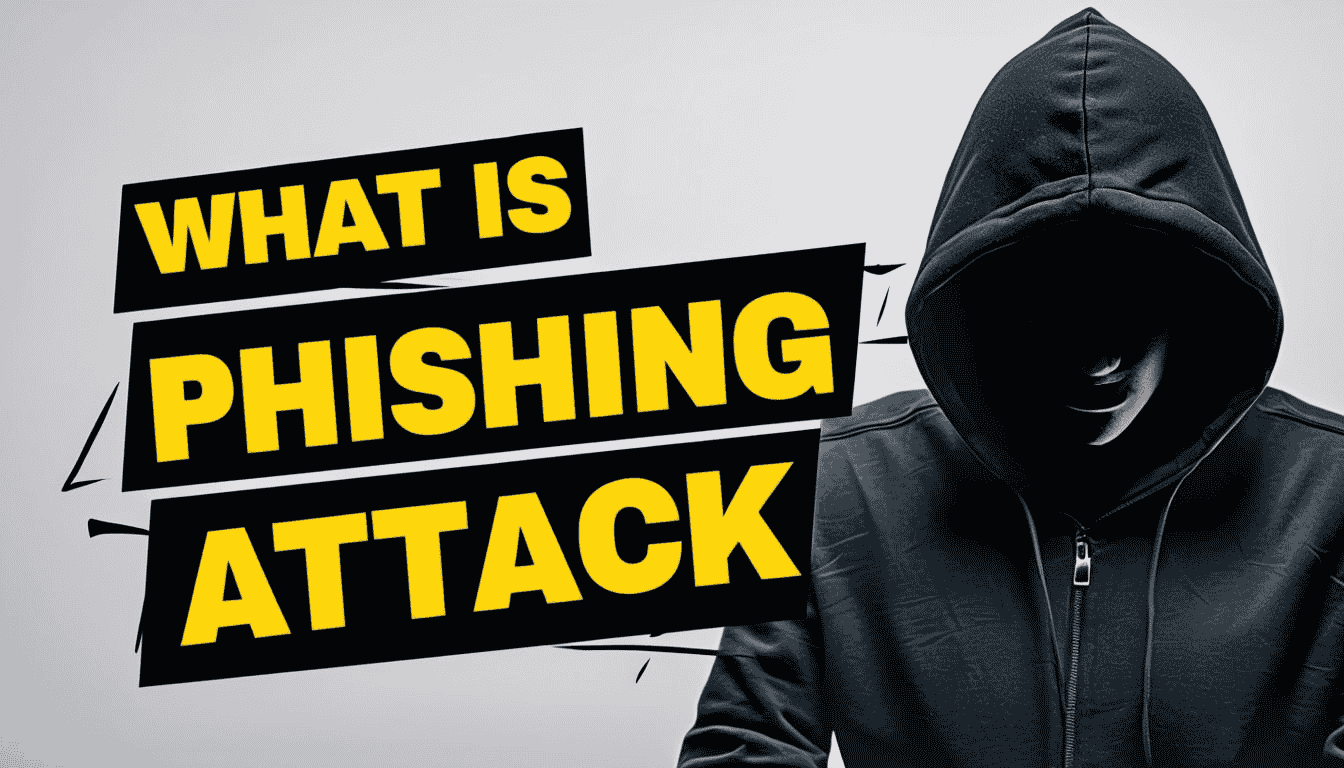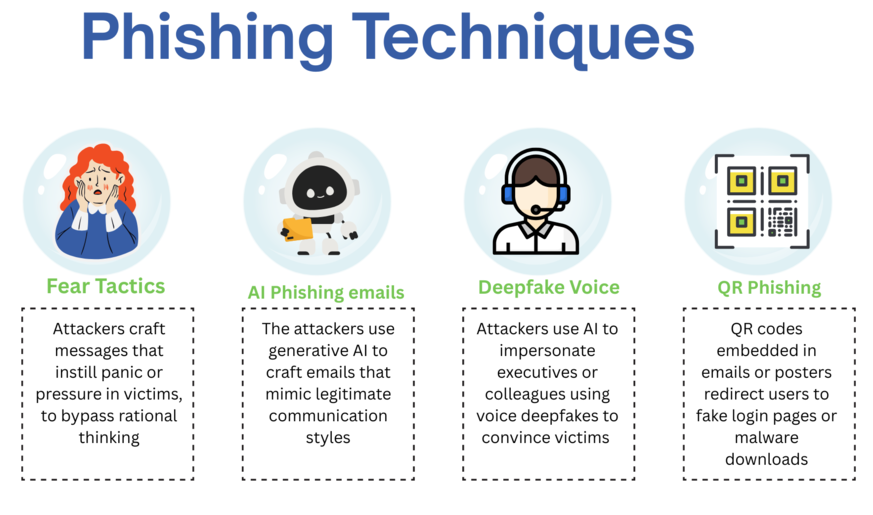
Phishing is a type of cyberattack in which hackers use fake websites, emails, or messages to appear as trustworthy organizations to install malware, steal login information, or obtain financial information.
Did you know?
According to Verizon DBIR, phishing attacks are the cause of more than 36% of data breaches and cost victims billions of dollars every year.
Knowing phishing and how phishing attacks are carried out is essential to safeguarding your personal information and data, whether it be an urgent email from your "bank" or a dubious link from a coworker.
In this article, we explain phishing, various types of phishing attacks, how phishing attacks are carried out, tips for identifying phishing scams, and practical strategies to prevent phishing attacks.
Furthermore, if you are interested in educating yourself about cyber security, you can explore some of our online cyber security courses.
What is a Phishing Attack?
A phishing attack is a cyber threat in which attackers impersonate trustworthy sources in an attempt to trick victims into disclosing private information, such as credit card numbers, passwords, or personal details.
These attacks usually take the shape of phony emails, texts, or websites that are meant to appear authentic. The major objective is to deceive victims into revealing private information or clicking on harmful links.
Phishing is recognized as a major threat because it exploits human psychology rather than system vulnerabilities. Cybersecurity experts emphasize the importance of awareness and education to prevent phishing attacks, as they can lead to data breaches, financial losses, and identity theft.

How Phishing Works?
A phishing scam begins with a message delivered through email, social media, or other forms of digital communication. The core goal is to deceive the recipient into taking action that compromises their personal or professional data.
Phishers frequently use publicly accessible data, particularly from social media sites, to investigate their targets. Details such as a person’s name, job role, email address, hobbies, or even workplace relationships can be gathered to craft convincing, personalized messages. This background data helps attackers create messages that appear credible and familiar.
These phishing messages are often designed to look like they're from trusted contacts or well-known organizations. They may include infected attachments or links to fake websites that closely mimic legitimate ones, like a bank, company portal, or university login page. Once the victim enters their credentials or other sensitive information, the attacker gains access.
While some phishing emails can be spotted due to poor grammar, off-brand visuals, or inconsistent design, many are becoming harder to detect. Today’s cybercriminals use advanced tools and marketing strategies to craft highly realistic, professional-looking messages that increase the likelihood of success.
Read Our Article on Best Cybersecurity Tools
Common Phishing Techniques in 2025
An attacker might use different types of phishing techniques to scam their victim. Some of the most prevalent phishing techniques in 2025 are:
1. AI-Powered Phishing Emails: The attackers use generative AI to craft emails that mimic legitimate communication styles, making them nearly indistinguishable from real messages. Generative AI reduces any chances of human error and makes the email really convincing.
Read about Artificial Intelligence and Machine Learning
2. Deepfake Voice Phishing: Attackers use AI to impersonate executives or colleagues using voice deepfakes to convince victims to authorize transactions or share sensitive data. Attackers can train AI to make a similar voice by training it with the original voice.
3. Malicious QR Code Phishing: QR codes embedded in emails or posters redirect users to fake login pages or malware downloads. These are harder to detect and are increasingly used in mobile-based attacks.
4. Urgency or Fear Tactics: Attackers craft messages that instill panic or pressure in victims, to bypass rational thinking and get the victim to click a malicious link, download malware, or provide sensitive information without verifying the source. These emails or texts often claim that an account has been compromised, a payment is overdue, or legal action is imminent.
5. Social Engineering: This technique involves psychological manipulation. Attackers gather personal details from social media, data breaches, or public records to tailor their messages. By referencing familiar names, locations, or recent activities, they build trust and credibility. This personalization makes the phishing attempt more convincing and increases the likelihood of the victim responding or complying.

11 Types of Phishing Attacks
There are different types of phishing attacks, and understanding each is the first step toward recognizing and avoiding them. Below, we have explained 10 different types of phishing with examples to help you stay safe in an increasingly deceptive digital world.
1. Email Phishing
Email phishing is the most common form of phishing, in which attackers send fraudulent emails that appear to be from legitimate sources. These emails often contain urgent messages or lotteries designed to trick recipients into clicking malicious links, downloading infected attachments, or revealing sensitive information.
Example:
In 2016, hackers sent fake emails to employees of the Democratic National Committee, appearing to be from Google. The emails warned of unauthorized login attempts and urged recipients to change their passwords via a malicious link. Clicking the link led to a fake login page, allowing attackers to steal credentials and access sensitive campaign data.
2. Spear Phishing
Spear phishing is a highly targeted and personalized form of phishing attack. Attacker research about victims to create personalized messages that appear trustworthy. The goal is to exploit familiarity or authority to gain access to confidential data or systems.
Example:
In 2015, Ubiquiti Networks Inc. suffered a $46.7 million loss due to a spear phishing attack. Cybercriminals impersonated company executives and sent fraudulent emails to the finance department, requesting wire transfers. The emails were highly targeted and convincing, leading employees to unknowingly transfer funds to overseas accounts controlled by the attackers.
3. Whaling
Whaling is a specialized form of spear phishing attack that targets high-profile individuals within an organization, such as executives, CEOs, CFOs, or other senior officials. These attacks are meticulously crafted to appear as legitimate business communications, often involving financial transactions or sensitive corporate matters.
Example:
In 2016, a finance executive at Mattel, Inc. received an email that appeared to be from the newly appointed CEO, authorizing a $3 million wire transfer to a bank in China. The email was part of a whaling attack targeting top-level staff..
4. Vishing (Voice Phishing)
Vishing, or voice phishing, is a type of phishing attack conducted over the phone. Attackers impersonate representatives from legitimate organizations like banks, tech support, using social engineering tactics to build trust and urgency. They then manipulate victims into divulging confidential information.
Example:
In 2020, attackers used vishing to breach Twitter’s internal systems. They called employees, posing as IT staff, and convinced them to reveal login credentials. This allowed hackers to access high-profile accounts like Elon Musk and Barack Obama, which they used to post a Bitcoin scam..
5. Smishing (SMS Phishing)
Smishing, or SMS phishing, involves attackers sending fraudulent text messages that appear to come from legitimate sources. These deceptive text messages are designed to trick recipients into clicking on malicious links or providing personal information.
Example:
A Sydney woman lost her life savings in a smishing attack where she received a fake SMS from what appeared to be her bank. The message warned of suspicious activity and directed her to a fraudulent link mimicking the bank’s website. She entered her credentials, unknowingly giving attackers full access to her account.
6. Clone Phishing
Clone phishing involves attackers creating a nearly identical copy of a legitimate email that the victim has previously received. The cloned email contains malicious links or attachments and is sent to the victim, making it appear as a follow-up to the original.
Example:
In 2023, attackers exploited a vulnerability in Barracuda’s email gateway system to launch clone phishing attacks. They replicated legitimate emails previously received by users and replaced original links with malicious ones. These cloned messages appeared authentic and were sent from trusted contacts, making them highly effective in bypassing security filters and deceiving recipients.
7. HTTPS Phishing
HTTPS phishing involves attackers creating fraudulent websites that use HTTPS to appear secure and trustworthy. These sites often display the padlock icon, misleading users into thinking they are legitimate. Attackers use these sites to steal sensitive information, such as login credentials and financial data.
Example:
A cybersecurity awareness trainer received an email inviting them to speak at an upcoming virtual conference. The RSVP link led to a professional-looking HTTPS website where they were asked to log in with their Google credentials, harvesting the login data in the process.
8. Pop-Up Phishing
Pop-up phishing involves fraudulent messages that appear as pop-ups while users are browsing the web. These pop-ups often claim there is a security threat or technical issue, urging users to click on links or call a phone number for support.
Example:
While browsing a forum, a user received a pop-up alert stating: “Your Windows license has expired. Click here to renew.” The fake support window led to a site that prompted the user to install a remote access tool masked as a system fix.
9. Evil Twin Attack
Fake Wi-Fi networks, also known as rogue Wi-Fi networks, are set up by cybercriminals to trick users into connecting. Once connected, attackers can monitor internet traffic, steal login credentials, inject malware, and intercept communications.
Example:
In 2020, the U.S. Department of the Interior's Inspector General team conducted a test using Evil Twin attacks. They set up fake Wi-Fi hotspots near government buildings using $200 kits and open-source software. Employees unknowingly connected, allowing the team to intercept credentials and access internal systems, exposing serious vulnerabilities in the department’s wireless infrastructure.
10. Watering Hole Attack
A watering hole phishing attack is a cyberattack where attackers compromise a website frequently visited by a specific group, such as employees of a particular organization. The attackers inject malicious code into the site, which then infects visitors' devices with malware.
Example:
In 2015, attackers compromised a Forbes ad server to target visitors from government and banking networks. They embedded malware exploiting vulnerabilities in Flash and Internet Explorer. When users from specific networks visited Forbes, their systems were infected, while others were ignored to avoid detection.
10. Pharming
Pharming is a type of phishing attack that redirects users from legitimate websites to fraudulent ones without their knowledge. This is often achieved by exploiting vulnerabilities in DNS (Domain Name System) settings or by installing malicious code on a victim's device.
Example:
The DNSChanger malware is one of the most notorious pharming attacks. It infected over four million computers globally by altering DNS settings, redirecting users to malicious websites without their knowledge. Victims believed they were visiting legitimate sites, but their traffic was rerouted to fraudulent pages designed to steal login credentials, financial data, and other sensitive information.
How to Detect a Phishing Email?
Phishing emails remain one of the most common and damaging forms of phishing attacks, with hackers constantly innovating to bypass security filters and deceive users.
To combat these threats, modern email security systems employ a range of advanced detection techniques. Below are some of the most effective methods used to identify and block phishing attempts before they cause harm.
1. AI-Powered Phishing Detection
Advanced email filters now use artificial intelligence (AI) and machine learning (ML) to detect phishing attempts with remarkable precision. By learning from large datasets, AI models can predict the likelihood of a message being malicious and quarantine or block it in real time.
2. Behavioral Analysis
Instead of just analyzing the message itself, behavior-based detection focuses on how users behave after interacting with an email. This technique is especially useful for detecting credential theft and insider threats resulting from successful phishing.
3. URL and Link Filtering
URL filtering scans embedded links to check for known malicious domains, lookalike URLs, suspicious redirect chains, or links hosted on recently registered or blacklisted domains. Suspicious links are often blocked or replaced with warning pages.
4. Deep Email Content Scanning
Email scanning tools inspect incoming emails for phishing indicators within the text, headers, metadata, and attachments. Some systems run attachments through sandbox environments, where files are executed in isolation to observe any malicious behavior
5. Threat Intelligence and Collaborative Defense
Phishing campaigns often target multiple organizations using similar methods. By tapping into threat intelligence feeds and sharing attack data across industries, security tools can rapidly identify new threats.
6. Dedicated Anti-Phishing Tools
Many companies now deploy specialized anti-phishing solutions that integrate several detection layers, from AI-driven content filtering to real-time link analysis and user reporting mechanisms.
How to Protect Yourself From Phishing
One valuable tool to help stay safe is a phishing link checker. These online tools allow you to input suspicious URLs to verify whether they lead to malicious websites. Using a phishing link checker can help prevent falling victim to phishing scams.
The following are the other common techniques:
1. Always check the sender's email address for authenticity before clicking on any links or attachments.
2. Install and regularly update anti-phishing software and browser extensions.
3. Hover over links to see the actual URL before clicking. Avoid clicking on suspicious links.
4. Stay informed about common phishing tactics and how to recognize them.
5. Add an extra layer of security to your accounts by enabling two-factor authentication.
What to Do if You Are Compromised in a Phishing Attack?
Knowing exactly what steps to take immediately after suspecting a phishing attempt is essential for protecting your personal information and minimizing risks. The following guidelines will help you respond effectively and safeguard your accounts and devices
1. Change your passwords immediately for any accounts that might be compromised.
2. Notify your IT or security team as soon as possible.
3. Run a full malware and antivirus scan on your devices.
4. Monitor your financial and online accounts closely for any unusual activity.
5. Report the phishing incident to help your organization respond effectively.
6. Avoid clicking any more links or opening attachments from the suspicious message.
Most Targeted Industries by Phishing Attackers
| Industry | Why Targeted |
|---|---|
| Financial Services | Access to funds & private data |
| Healthcare | Sensitive medical/financial info |
| Education | Mixed users & weak security |
| Government | Classified/state data |
Interesting Statistics on Phishing
● Phishing attacks are projected to cause over $45 billion in global financial losses in 2025, which is a significant increase from $40 billion in 2024.
● Phishing attacks result in an estimated $17,700 in losses every minute.
● Business Email Compromise (BEC) phishing attacks cost businesses an average of $4.91 million per incident in 2024.
● Over 1.2 billion phishing emails are sent daily, with spear phishing accounting for 65% of targeted attacks.
Conclusion
Understanding what phishing is and how phishing attacks operate is crucial in today’s cyber world. By recognizing suspicious emails, learning about different types of phishing attacks, and using tools like a phishing link checker, you can protect yourself from becoming a victim of a phishing scam. Always stay alert and think twice before sharing your sensitive information online.
Gautam Kumar is a senior network engineer having more than 7 years of experience in different companies in India. His work experience in network support and operation and maintaining of any network makes him one of the most valuable IT professional in industry. He has been involving in planning, supporting the physical and wireless networks, ...
More... | Author`s Bog | Book a MeetingFAQ
Comments (0)
Popular posts


Different Types of Network Topologies ...
8 Aug 2025
CCNA Exam Fees and Expenses Breakdown
9 Apr 2025
New Cisco CCNA Syllabus for 2025
2 Apr 2025
Palo Alto Exam Cost: PCNSA, PCNSE & More
28 Apr 2025Recent posts

What are Email Protocols in Computer ...
14 Aug 2025.jpg)
What is NAT in Networking and How NAT ...
14 Aug 2025
What is Switching in Networking? Its ...
14 Aug 2025
What is Routing and Its Types?
14 Aug 2025
What is Cloud Computing in Simple Words?
13 Aug 2025Upcoming batches
Contact learning advisor










